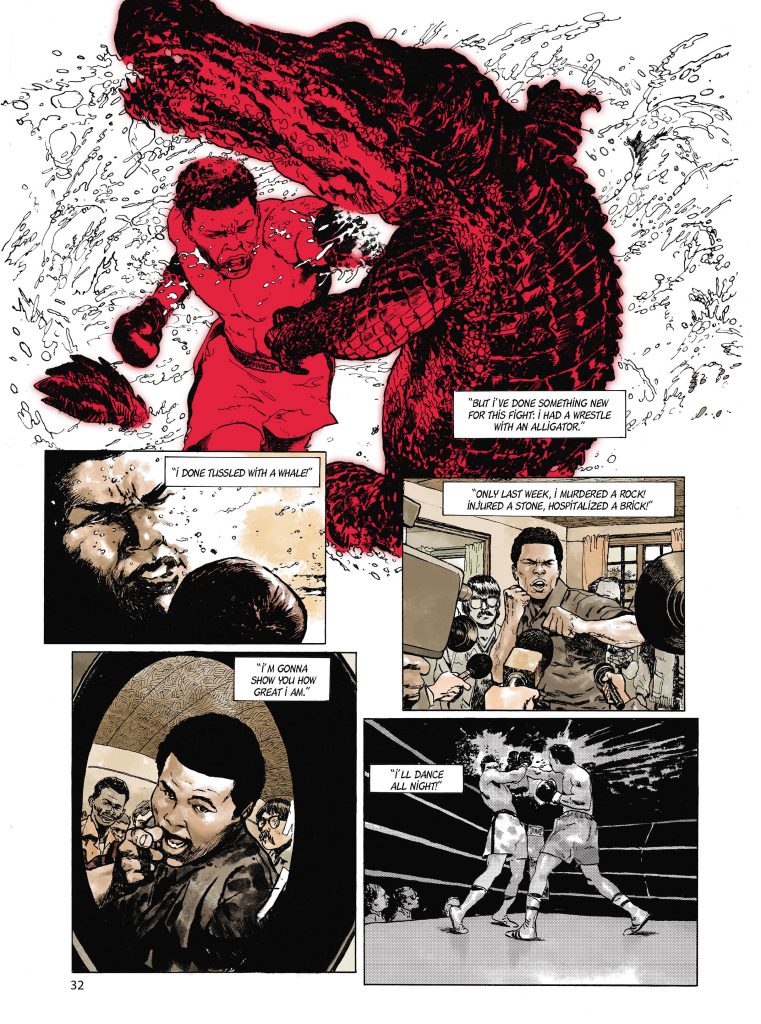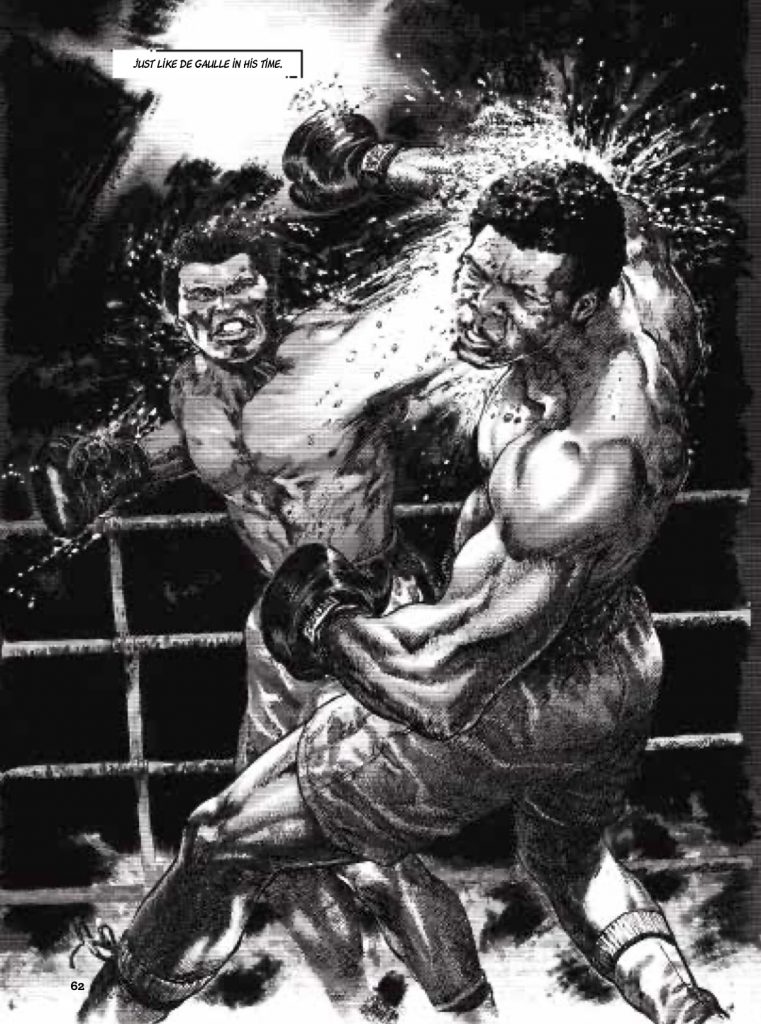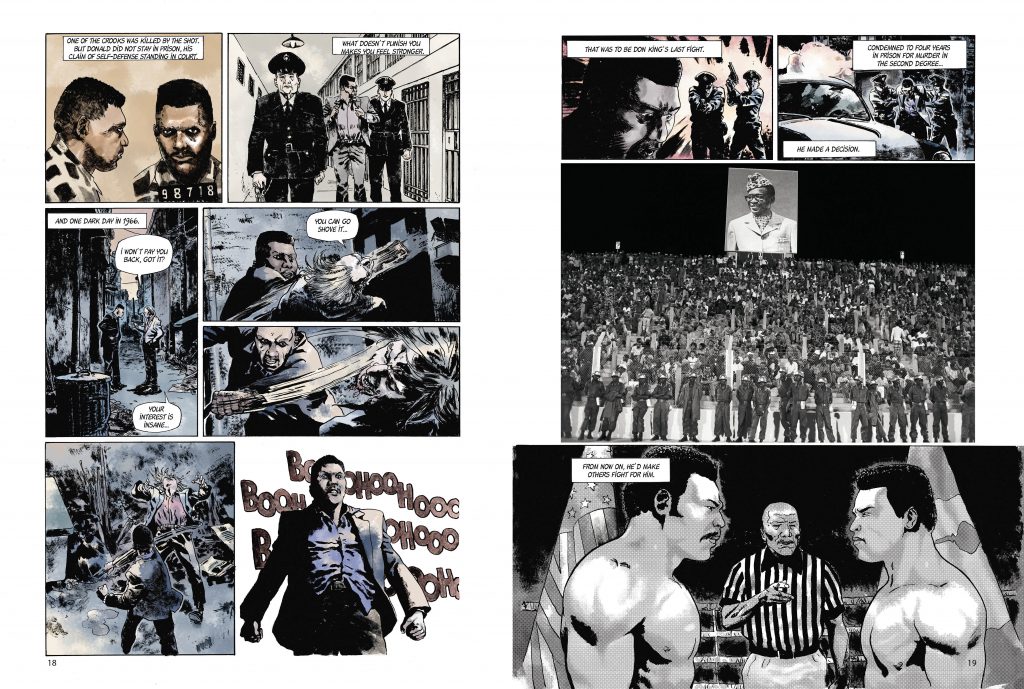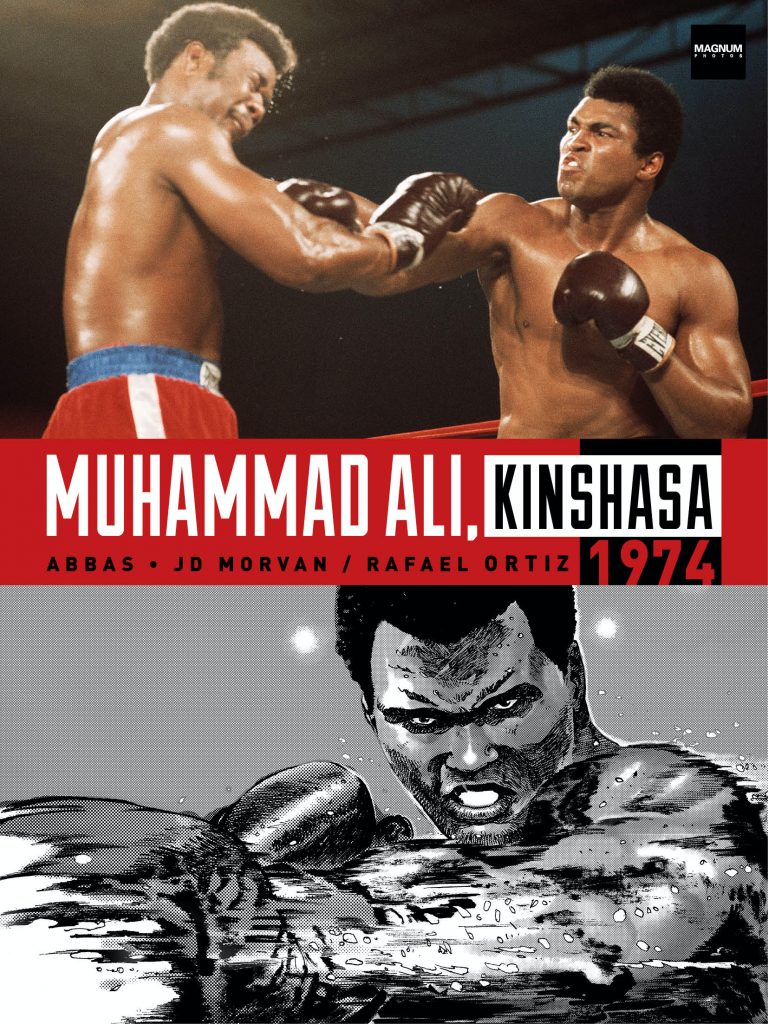
- Muhammad Ali, Kinshasa 1974
- Titan Comics
- Photographs by Abbas
- Written by Jean-David Morvan
- Illustrated by Rafael Ortiz
- Colors by Hiroyuki Ooshima
Growing up in the 70’s, there couldn’t have been anyone in the world who didn’t know who Muhammad Ali was. More than a boxer or professional athlete, Ali was the epitome of the self-promoting genius and cerebral tactician. Outside the ring, he was featured on television, in comics (vs Superman, no less!), and in his own cartoon series. Without a doubt, Ali’s natural abilities supplemented by skills earned through constant effort and refining took him far, but it was his ability to analyze an opponent and to tailor his strategies to suit each fight that made him a legend.
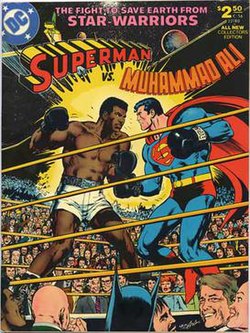
Maybe you’re thinking that use of the word “legend” might be a little too much? Okay, let’s break it down. Kicking off his amateur boxing career under his given name Cassius Clay, Ali racked up six Kentucky Golden Gloves titles, three national titles, a gold medal in the 1960 Summer Olympics, and ended his amateur career with 100 wins & 5 losses. Debuting as a professional boxer in 1960, he added to his story by earning a 19-0 record in a three year span. In 1964, Ali challenged Sony Liston for the heavyweight championship and goaded the much larger fighter into a series of reckless attacks that allowed Ali to pick him apart and earn a TKO (Liston was unable to answer the bell signaling the start of the seventh round) win for the belt.
![[clay-liston2.jpg]](http://1.bp.blogspot.com/_lF7wBVgGr9E/ReJB0-U9E-I/AAAAAAAAAC8/aGsQwbSGqqM/s1600/clay-liston2.jpg)
Muhammad Ali was 22 years old.
After successfully defending his title against former champ Floyd Patterson in 1965, Ali founded his own promotional company, Main Bout, to handle his own boxing promotions and pay-per-view broadcasts. His career was complicated by controversy when Ali refused to report for military service in Vietnam after being drafted, stating, “I ain’t got nothing against no Viet Cong.” Being unable to line up fights in the U.S. and stripped of his title in response to the draft refusal, Ali went international and gathered more titles in Canada & Europe.
Returning to the states saw continued controversy for Ali as he mounted some spectacular wins as well as some pointed criticisms and eventually losing his boxing license. From 1967 to 1970, Ali was unable to fight professionally as his case went through the appeal process. His license reinstated, Ali returned to the ring against Jerry Quarry, and again in Madison Square Garden against Oscar Bonavena. In 1971, Ali fought reigning champ Joe Frazier, in what was billed as “The Fight of the Century” and resulted in Ali’s first professional defeat by decision. 1972 saw Ali bounce back with a total of six fights & six victories. 1973 gave Ali his second loss when his jaw was broken in a bout with Ken Norton. 1974 brought a rematch against Frazier, which won him a unanimous decision victory.
All of that leads us into the fabled “Rumble in the Jungle”, a fight that put a capstone to Ali’s career as he was set to face heavyweight champ George Foreman. This also brings us (finally, you might be thinking) to the subject of this book from Titan Comics, Muhammad Ali, Kinshasa 1974, a concept that’s as awesome as it is groundbreaking. The idea was to take the photographs you’ve probably already seen in publications like Time Magazine, or on display at the Smithsonian Institute, and build on them through the medium of comics. Using eye witness accounts, previously unpublished photos, and historical record, the madness leading up to the fight against Foreman is brought to sequential life.
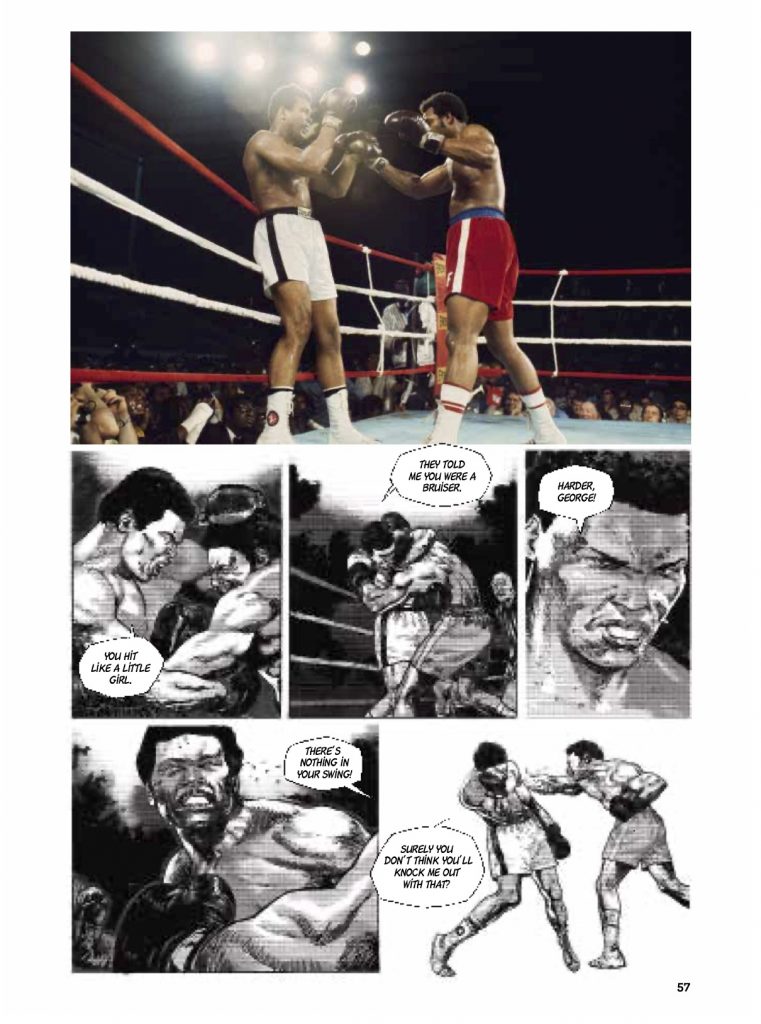
Before you start to think that this whole thing is nothing but a Muhammad Ali lovefest, keep in mind that no stone is left unturned. Writer Jean-David Morvan touches on Ali’s very real and well-earned fear of the power of George Foreman (he’d defeated all of the fighters who had ever beaten Ali and was known to hit like a wrecking ball), his arguably devious tactics leading up to the fight as he strove for every conceivable advantage, and his meticulous deconstruction of Foreman’s state of mind as he waged a war of wits & will at every opportunity. Morvan shows Ali’s idea to put a little give in the ropes on the sly, a ploy that allowed him to lessen the impact of Foreman’s punches as he worked his “rope a dope” tactic. Also, Morvan takes his story out of the spotlight, to put some attention on George Foreman’s experiences in the African country, as well as giving high profile & often controversial promoter Don King some perspective. Being able to tap into the personal experiences and observations of photographer Abbas (full name, Abbas Attar, who passed away on April 25, 2018), there to capture the massive event in pictures, adds depth to a story that was sensationalized in the media, tailored to tell the narrative chosen and orchestrated in large part by Ali himself.
Filling in the story surrounding the famous photographs was the job of artist Rafael Ortiz. Using the pictures and firsthand accounts as a framework, Ortiz turned to the task of closing the gaps. His work captures the dynamics of a professional boxing match, showing these larger than life figures in action as they made history. While a comic book artist might be in their element in illustrating a fight, Ortiz’s work also encompassed a lot of what went on leading up to the match, as well as behind the scenes. We’re not only given a look at the earlier life of Ali himself, shown in these pages as a youngster looking for something to commit to and excel at, but we’re also shown a bit of Don King’s origin story. Ortiz digs into all of it with an eye to the details, and is able to bring it to the page without missing a step.
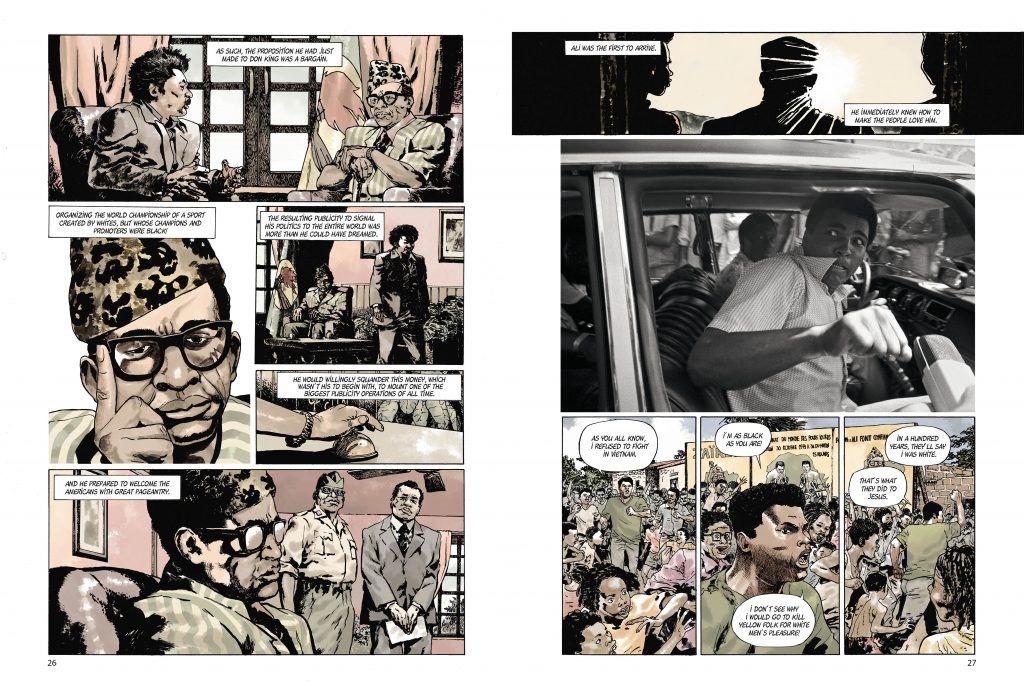
Far from being the biggest achievement in Ali’s storied career, the events featured in Muhammad Ali, Kinshasa 1974 provide a snapshot of a larger than life figure. He’s been featured in movies, television shows, documentaries, cartoons, and comics, but Kinshasa 1974 gets a little bit closer to the man than the myth previously did. Going a little further, it also broadens the gaze, letting readers see more of what went on before, during, and around the historic heavyweight fight.
I’ll be looking forward to grabbing this one when it hits the shelves. If I’ve said anything here that’s in any way piqued your curiosity, you might want to think about putting some pennies aside to do the same.
Final Score: 13/13
